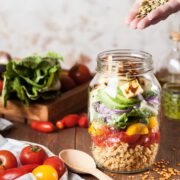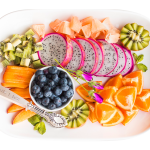5 Flat-belly Foods To Eat This Summer
By Sally Shi-Po Poon (Dietitian)
You’ve been exercising hard and eating clean for weeks to get a flat belly this summer. However, you may wake up some days feeling bloated and miserable. Whatever the reason is – it can be the menstrual cycle, eating too much salt or something else; here are foods and dietary tips that can reduce bloating!
- Yoghurt
Yoghurt is rich in protein, calcium and potassium. It also contains probiotics which help maintain a healthy digestive system. Among low-fat, fat-free, plain, flavoured and Greek — the choices can be overwhelming when you are doing the grocery shopping! In general, it is better to choose low-fat or fat-free yoghurts as they contain less saturated fat which can help improve blood cholesterol profiles. Added sugar is a common ingredient in fruited or flavoured yoghurt. Instead, choose plain yoghurt and add your own fruits or flavours such as vanilla, cinnamon or a drizzle of honey. Greek yoghurt is strained so its texture is thicker and creamier than regular yoghurt. Yoghurt contains less lactose than milk so is easier to digest for people who are lactose intolerant. You can use yoghurt to make yoghurt parfaits, smoothies, ice cream/ ice lollies, and dips.
- Kiwis
Kiwis are very rich in vitamin C, potassium and fibre. Regular consumption of kiwis has proven to have beneficial effects on immune function and gastrointestinal function. Research found individuals with constipation had their bowel function improved after consuming two green kiwis a day for 4 weeks.
- Bananas
Many people thought bananas are high in carbohydrates and therefore fattening. In fact, one medium banana contains only 105 kcal and 3.1 grams dietary fibre. It is a great source of potassium, a mineral that helps regulate your body’s sodium level and remove the excessive amount of water. It’s an excellent way to counteract the excessive consumption of sodium from frequent takeaways!
- Flaxseeds
If you have constipation, try dietary supplementation of flaxseeds of up to 2 tablespoons a day for a 3-month trial. Try adding flaxseeds to breakfast cereal, yoghurt, soup or salad. Have a small glass (150ml) of fluid with each tablespoon of flaxseeds taken. Flaxseed oil does not contain any dietary fibre; however is an excellent source of omega-3 fatty acids that are beneficial to heart health.
- Tomatoes
Tomatoes contain fibre and potassium which can relieve bloating. Tomatoes are also a source of lycopene, which is a powerful antioxidant. Research found that lycopene may help protect skin from sun damage and reduce the risk of prostate cancer. The absorption of lycopene is greater from processed tomatoes (such as canned tomatoes, tomato paste, ketchup, soup and juice) than fresh tomatoes. This is because the food processing breaks down the tomato cell matrix and makes the lycopene more available. Addition of oil to tomatoes during cooking also greatly increases the absorption of lycopene.
Extra dietary tips that can help you feel less constipated and bloated:
- Aim for 5 or 6 small meals/ snacks each day on a regular schedule. Do not skip meals!
- Slowly increase the amount of fibre you eat to 25 to 35 grams per day. Choose whole grains (such as whole wheat, rye, oats, bran, and brown rice), seeds, nuts, and fruits and vegetables.
- Drink plenty of fluids – aim at least 8 cups per day. You may need even more with higher amounts of dietary Fluid helps your body process fibre without discomfort.
- If you experience a lot of bloating and wind, limit intake of gas-producing foods such as legumes and lentils, onion, Brussels sprouts, cauliflower, leeks, sugar-free candies or chewing gum, and beverages sweetened with high-fructose corn syrup or sorbitol.
Sally’s Nutrition Blog @ Hong Kong Tatler: http://hk.asiatatler.com/wellness/5-foods-to-eat-for-a-flat-belly










Leave a Reply
Want to join the discussion?Feel free to contribute!